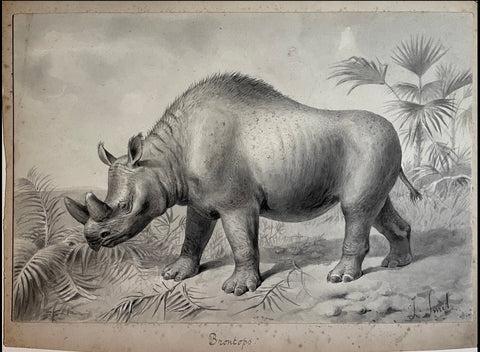
Joseph Smit (1836-1929), Brontops
Joseph Smit (1836-1929)
Brontops
Original Illustration in pen, ink and grey wash, heightened in white
c. 1905-1912
7 1/8 x 10 1/2 in. sheet
Original artwork for Henry R. Knipe’s Nebula to Man. Titled Brontops/From remains found in Oligocene strata of
Dakota, U.S.A.
Megacerops (“large-horned face”, from méga- “large” + kéras “horn” + īps “face”) is an extinct genus of the prehistoric odd-toed ungulate (hoofed mammal) family Brontotheriidae, an extinct group of rhinoceros-like browsers related to horses. It was endemic to North America during the Late Eocene epoch (38–33.9 mya), lasting approximately 4.1 million years.
Megacerops includes Menodus, Brontotherium, Brontops, Menops, Ateleodon, and Oreinotherium genera.
Despite resembling the rhinoceros, it was larger than any living rhinoceros: the living animal easily approached the size of the African forest elephant, the third-largest land animal today. It stood about 8 ft 2 in tall at the shoulders with an overall length (including tail) of 15.2 ft.
JOSEPH SMIT (1836-1929)
Josef Smit’s dinosaur drawings are a high point in his fine draughtsmanship and unique in his vision to construct an image based on a written description rather than a physical specimen. Knipe’s preface indicates that Smit also learned much from Charles Knight’s drawings at the Museum of Natural History, New York.
Josef Smit was born and raised in Lisse, in southern Holland. Later, in Leiden, his scientific fidelity came to the Natural History Museum of Leiden director Hermann Schlegel’s attention. He presented the artist with his first commission to paint a series of birds from the Dutch East Indies. Smit’s work for Schlegel earned him a significant commission to prepare hundreds of plates for Philip Sclater’s Exotic Ornithology. Once in London, the artist met other like-minded artist-naturalists and developed a reputation for preparing very realistic drawings. Because of his ability to delineate every detail of a specific bird, he was employed by several scientists to illustrate their reports and publications. His work stood apart from his contemporaries in his addition of thorough backgrounds of leaves, vines, and tree branches. Smit eventually became a key contributor to some of the most important natural history publications of the 19th and early-20th centuries. His work graced the tomes by John Gould, Edward Lear, Archibald Thorburn, Henry Constantine Richter, and J.G. Keulemans. His son, Pierre-Jacques Smit was also a skilled watercolorist.
ORIGINAL WATERCOLORS PREPARED FOR HENRY KNIPE’S
NEBULA TO MAN (1905) & EVOLUTION IN THE PAST (1911-1912)
An exceedingly rare collection of original watercolors prepared for Henry Knipe’s Nebula to Man (1905) and Evolution in the Past (1911-1912) by naturalist-artists Alice Woodward, Josef Smit, and Charles Whymper.
Drawings prepared for Knipe’s Nebula to Man (1905) contributed to one of the most important publications on dinosaurs on the heels of the Great Dinosaur Rush or Bone Wars. The Bone Wars occurred between 1877 and 1892 between Edward Drinker Cope, the Academy of Natural Sciences Philadelphia, and Othniel Charles Marsh, the Peabody Museum of Natural History at Yale. These early paleontologists fought ruthlessly to pursue dinosaur fossils, a quest that resulted in an extraordinary period of discovery and the eventual financial ruin of both scientists. Their findings resulted in unearthing 136 new dinosaur species, ushering in a new paleontological research era.
According to Henry Knipe’s obituary, he worked for the British Museum. It was there that he likely met the artists tapped for this project. Knipe chose each illustrator for their reputation for scientific authenticity—namely, those skilled as bird artists, given the many similarities between bird species and dinosaurs.
We Also Recommend

![Albertus Seba (1665-1736) Tab I [Insects]](http://aradergalleries.com/cdn/shop/products/I_large.jpg?v=1635434052)
![Albertus Seba (1665-1736) Tab II [Insects]](http://aradergalleries.com/cdn/shop/products/II_large.jpg?v=1635434726)
![Albertus Seba (1665-1736) Tab III [Insects]](http://aradergalleries.com/cdn/shop/products/III_large.jpg?v=1635434877)
![Albertus Seba (1665-1736) Tab L [Insects]](http://aradergalleries.com/cdn/shop/products/L_b_large.jpg?v=1635435506)
![Albertus Seba (1665-1736) Tab L [Insects]](http://aradergalleries.com/cdn/shop/products/L_large.jpg?v=1635437893)